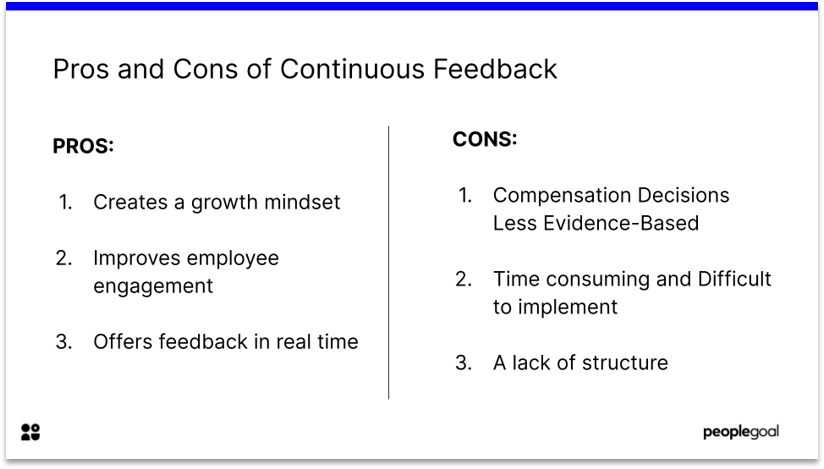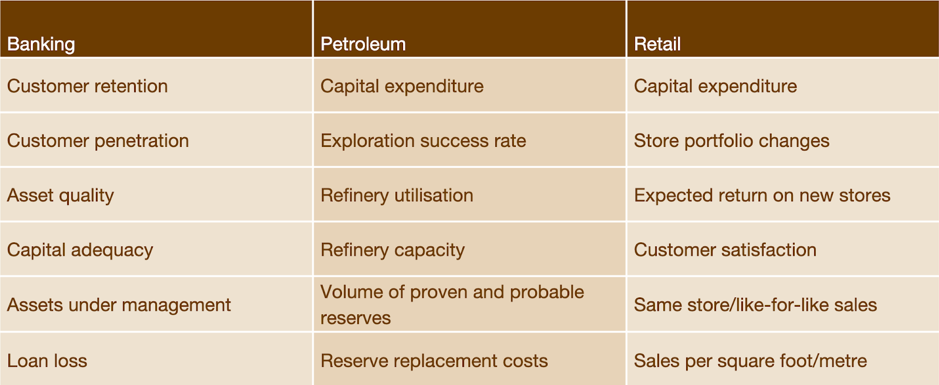The world of performance management is shifting. Companies are no longer restricted to annual performance reviews in the way they provide feedback to staff. Organizations such as Dell, Microsoft and IBM have abandoned performance reviews, recognizing the need to overhaul their people processes.
However, are new methods working? According to a revealing Gartner study, companies which abandoned performance review ratings saw a 10% drop in performance. Performance review ratings are widely deemed unpopular, yet employee engagement also saw a 6% fall after they were removed.
Organizations such as Dell, Microsoft and IBM have abandoned performance reviews
Evidently, feedback is a complex area in which there is no one-size-fits-all. If organizations replace traditional performance reviews, they need to find a workable alternative. We all require feedback to learn and improve.
Continuous feedback may be the solution. This involves working performance conversations into the everyday life of your organization. Managers give employees feedback for daily tasks and set goals with their team. They recognise action towards these targets and offer suggestions for improvement in real-time.
In this blog, we review the Pros and Cons of Performance Reviews and Continuous Feedback. We consider what strategy works best for different company cultures.

Performance Reviews
Performance reviews are a performance management touchstone. Formal appraisals were first widely used in the military, to rank soldiers and identify potential leaders.
Traditionally, performance reviews were annual. In recent years, yearly performance reviews have been found wanting, and it’s not uncommon to see reviews on a quarterly basis.
To find out more about Performance Reviews, read our Essential Guide here 📖

Pro 1: Ratings benchmark employees
Ratings condense performance into a numerical value, for example ‘Exceeds expectations = 5’ or ‘Satisfactory = 3’. While this is often viewed as reductive, it can give HR leaders a birds’ eye view of performance in the organization.
For example, if many employees from one team are underperforming, it is clear that HR should consult the team’s manager. If an employee needs to improve their performance, a rating is a wake-up call for their manager and HR to develop an improvement plan and set achievable goals with them.
Without ratings, HR would struggle to gauge an overall view of performance. From an employee perspective, ratings enable you to see how your performance fits in with the team overall.

Pro 2: Combat bias
As they place feedback into a formal framework, performance reviews can reduce bias. HR has oversight on the feedback managers give to employees. Managers must evidence all their reviews with concrete examples – rather than subjective comments about an employee’s character traits.
Additionally, formal performance reviews mean all employees receive feedback in equal measure. Coaching management styles can be powerful – motivating employees and making them feel valued.
However, managers often do not give every employee equal treatment. Affinity bias means that managers may give more of their time to people they feel are similar to them. Other biases, such as gender bias come into the mix.
According to a study by McKinsey and Company, women receive less frequent informal feedback than men, making it harder for them to advance their career development.
Performance reviews ensure that managers provide regular feedback to all employees. HR should train managers to coach their teams, and to be conscious of their own biases. However, appraisals offer a base level of feedback to support every employee as they grow their skillset.
Women receive less frequent informal feedback them men
Pro 3: Base compensation and rewards on performance
Compensation and rewards can be a grey area for HR. Performance reviews allow you to base compensation on the results employees achieve. This is both motivational and can make compensation fairer.
Performance Reviews: The Cons
Con 1: Reduce teamwork
While ratings are a time-saver from an HR perspective, employees compare themselves to their peers in a way that is often unhelpful. Ratings are applied subjectively – and sometimes reveal the bias of managers.
Performance reviews are also often linked to compensation. Some employees will miss out on rewards if they receive a certain (often unreliable) rating. As many achievements are a team effort – certain employees may not get their fair share of the credit.
Understandably, relationships within a team can fray. When teams work together effectively, they motivate one another and achieve great things. Finding a feedback process that cultivates supportive teams can have myriad benefits.
Con 2: De-motivates employees
What is the purpose of feedback? Feedback supports us to develop our skills so that we can take the next steps towards our goals. This requires motivation – moving forwards and believing in our abilities is an uphill battle.
Feedback must be motivational. Unfortunately, only 14% of employees say performance reviews inspire them to improve, according to Gallup research. A highly critical performance review can create stress for employees especially if they are concerned about their job security. This will not cultivate a growth mindset, especially if managers do not take the time to discuss their review one-on-one.
Additionally, if employees only receive feedback once in a blue moon, they will sometimes feel uncertain about how to improve. If managers do not make themselves available to offer pointers regularly, performance reviews will not facilitate employee development.
Con 3: Reviews are inconsistent
Every manager has their own feedback style. Some will take a more critical approach with their teams. Others will want to reward employees for a job well done – even where there is room for improvement.
When HR looks at performance across teams, their reporting won’t account for these different management styles. Is the marketing department stronger than the sales team, or is their manager just more punitive with rating scales?
Not only does this complicate things for HR, it also demotivates employees. They might feel alienated by a manager who does not give them the review they feel they deserve. Inconsistency reduces trust in the performance review process, meaning it is less likely to be impactful.
What company culture matches performance reviews?
Larger organizations can benefit from traditional performance reviews. They are an invaluable data pool as HR considers succession planning and compensation. Performance reviews make employees accountable for their performance. Sectors that require a high level of accountability can benefit from a formal structure. This is why government departments tend to maintain traditional performance reviews.
Most organizations require a formal review process of some description to provide structure. Continuous feedback provides a supportive approach grounded in the day to day operations of an organization. But performance reviews provide a formal framework which can help maintain
performance management as a priority.
To find out more company culture, read this blog post on HR’s culture role 👈
Continuous Feedback: The Pros and Cons

Pro 1: Creates a growth mindset
Annual performance appraisals are a bit like a final exam. All of the ups and downs of a year of work are condensed down into one review.
By contrast, continuous feedback encourages us to view our performance as a constant work-in-progress. Rather than a final exam, continuous feedback supports us along the marathon of our career.
This fosters a growth mindset. Negative or constructive feedback is given informally- it’s a normal part of daily life at work. Taking the sting out of criticism means employees take feedback less personally, and are more likely to address problem areas.

👉 Click here for 6 tips to success when giving constructive feedback
Pro 2: Improves employee engagement
Continuous feedback makes every individual feel valued. Their manager devotes time for every employee’s development, and recognizes their hard work.
In an ongoing feedback culture, employees are held accountable for short as well as long term goals. Their team celebrates every win – which boosts motivation and engagement.
Pro 3: Offers feedback in real time
According to a study by Clear Company, 94% of employees want real time feedback. Real time feedback means we can make changes in the moment. When a colleague or manager reviews a report you are writing before you publish it, you have time to incorporate their thoughts to improve your work.
Feedback of this kind can directly improve performance – rather than hindsight-based annual reviews that can leave employees feeling deflated.
Continuous Feedback: The Cons
Con 1: Compensation Decisions Less Evidence-Based
Typically, compensation decisions are made on the basis of a year’s performance: the annual performance appraisal. This includes a holistic view of an employee’s strengths and weaknesses. Continuous feedback provides a more fragmented perspective on performance – meaning that it can be difficult to determine salary and rewards.
Con 2: Time consuming and Difficult to implement
While performance reviews are notoriously time consuming, do not take on continuous feedback if you’re expecting to sit back and relax.
Most HR teams agree that continuous feedback needs to be aligned with goal setting. Managers must record each employee’s targets, alongside the team’s goals. They need to schedule time to check-in with their progress and talk one-on-one.
Con 3: A lack of structure
The absence of structure means some managers do not devote time to feedback. They may offer a few words of encouragement, but do not check in with employees regularly or follow up on their goals.
The danger is that teams end up with little to no meaningful feedback. As we’ve outlined above, coaching management styles can fall victim to bias and favoritism. Those who need the most support may be forgotten about in the absence of a structured performance management program.
What company culture matches continuous feedback?
Continuous feedback has benefits for every organization. Regular, informal feedback is taken onboard more easily than formal criticism that is tied to compensation. At the very least, it puts less pressure on employees by creating a culture in which feedback is based on growth.
Continuous feedback works well in innovative company cultures, such as start-ups. If employees bounce ideas off each other and give feedback freely, teams can solve problems and think creatively.
Remote teams can truly benefit from a culture of ongoing feedback. Dispersed teams experience communication challenges as they try to operate over Zoom. Providing more regular feedback reduces isolation – and can correct any miscommunications.

Performance Reviews or Continuous Feedback: Which Will You Choose?
While it’s important to weigh up the pros and cons of different performance management styles, in reality, most organizations need a combination of methods.
Performance reviews provide much-needed structure which can reduce problems with managerial bias. Continuous feedback is actionable – it tells us what we need to do to now to improve our work.
Continuous feedback and formal reviews complement each other. Be conscious of their advantages and disadvantages as you implement a performance management strategy.
PeopleGoal’s Performance apps create a hybrid approach to performance: from goals to one-on-ones to performance reviews.
To find out more about PeopleGoal’s apps, visit our App Store ⬅️
Ready to 3x Your Teams' Performance?
Use the best performance management software to align goals, track progress, and boost employee engagement.






